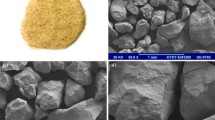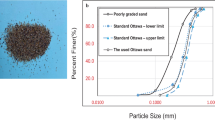Abstract
The geotechnical characteristics of hydrocarbon-contaminated soils have been an issue of major concern for its inevitable impacts on our surroundings from engineering as well as environmental viewpoints. The impact of hydrocarbon on various geotechnical properties of diversified soils have been reported in the literature. Nevertheless, shear wave velocity (Vs) of hydrocarbon-contaminated soils has not been precisely focused. This paper aims to investigate the shear wave velocity of crude oil contaminated silty sand by performing a series of bender element tests. The key influencing parameter is crude oil content (2, 4, 6, 8, 10, and 12%) in addition to frequency, confining pressure, and depth of contamination. The test results have been discussed for the values obtained within the consistency range of frequency. The results revealed that, petroleum contamination moderately increases the shear wave velocity initially up to a critical amount of crude oil and thereafter falloffs sharply. This critical value has been introduced as the transition point in the Vs profile. The effect of depth of hydrocarbon contamination has been explained in terms of contamination depth ratio (β). In a saturated state, shear wave velocity follows a non-linear trend with increasing depth of contamination and for β > 0.6, no substantial change was observed. There also exists a zero change point at which the positive and negative influences of crude oil contamination get counter-balanced and no net change in shear wave velocity of contaminated sand with respect to clean sand was observed. Beyond this point, the value of Vs drops below that of virgin sand.













Similar content being viewed by others
References
Abdullah W, Aljarallah R, Alrashidi A (2014) Hydrocarbon oil-contaminated soil assessmentusing electrical resistivity topography. J Eng Res 3(2):1–20
Addo K, Robertson P (1992) Shear-wave velocity measurement of soils using rayleigh waves. Can Geotech J 29(4):558–568
Akinwumi I, Diwa D, Obianigwe N (2014) Effects of crude oil contamination on the index properties, strength and permeability of lateritic clay. Int J Appl Sci Eng Res 3(4):816–824
Alhassan HM, Fagge SA (2013) Effects of crude oil, low point pour fuel oil and vacuum gas oil contamination on the geotechnical properties sand, clay and laterite soils. Int J Eng Res Appl 3(1):1947–1954
Al-Sanad HA, Eid WK, Ismael NF (1995) Geotechnical properties of oil-contaminated kuwaiti sand. J Geotechn Eng 121(5):407–412
Andrus RD, Stokoe KH II (2000) Liquefaction resistance of soils from shear-wave velocity. J Geotechn Geoenvironm Eng 126(11):1015–1025
Arroyo M, Wood DM, Greening PD, Medina L, Rio J (2006) Effects of sample size on bender based axial G0 measurements. Géotechnique 56:39–52. https://doi.org/10.1680/geot.2006.56.1.39
Arrubarrena-Moreno M, Arango-Galván C (2013) Use of electrical resistivity tomography in the study of soil pollution caused by hydrocarbons: Case study in Puebla (México). Boletín De La Sociedad Geológica Mexicana 65(2):419–426
ASTMD698 “Test methods for moisture-density relations of soils and soil-aggregate mixtures.” Method A (Standard Proctor)
ASTMD7181–11 “Standard test method for consolidated drained triaxial compression test for soils.” West Conshohocken, PA
ASTMD92 (2016) “Standard test method for flash and fire points by Cleveland open cup tester.” Annual Book of Standards
Bian H, Liu S, Chu Y, Cai G (2018) Estimation of oil-contaminated soils’ mechanical characteristics using electrical resistivity. In The International Congress on Environmental Geotechnics. Springer, Singapore, (pp. 645–652)
Brignoli E, Gotti M, Stokoe K (1996) Measurement of Shear waves in laboratory specimens by means of piezoelectric transducers. Geotechn Test J 19:384–397. https://doi.org/10.1520/GTJ10716J
Castelli F, Cavallaro A, Ferraro A, Grasso S, Lentini V, Massimino MR (2018) Dynamic characterisation of a test site in messina (italy). Ann Geophys 61(2):222
Cavallaro A, Grasso S, Maugeri M, Motta E (2013) “An innovative low-cost sdmt marine investigation for the evaluation of the liquefaction potential in the genova harbour, italy.” Geotechnical and Geophysical Site Characterization: Proceedings of the 4th International Conference on Site Characterization ISC-4, Vol. 1, Taylor & Francis Books Ltd, 637–644
Cook E, Puri V, Shin E et al (1992) “Geotechnical characteristics of crude oil-contaminated sands.” The Second International Offshore and Polar Engineering Conference, International Society of Offshore and Polar Engineers
Di Matteo L, Bigotti F, Ricco R (2010) Compressibility of kaolinitic clay contaminated by ethanol-gasoline blends. J Geotechn Geoenvironm Eng 137(9):846–849
Estabragh A, Beytolahpour I, Moradi M, Javadi A (2014) Consolidation behavior of two fine-grained soils contaminated by glycerol and ethanol. Eng Geol 178:102–108
Evgin E, Das B (1992) “Mechanical behavior of an oil contaminated sand.” Environmental Geotechnology, Usmen & Acar (Eds), Balkema, Rotterdam
George S, Aswarthy E, Sabu B, Krishnaprabha N, George M (2015) Study on geotechnical properties of diesel oil contaminated soil. Int J Civil Struct Eng Res 2(2):113–117
Ghadyani M, Hamidi A, Hatambeigi M (2019) Triaxial shear behaviour of oil contaminated clays. Eur J Environ Civ Eng 23(1):112–135
Hosseini SMR, Naeini SA, Hassanlourad M (2018) Pre-and post-cyclic behaviour of an unsaturated clayey soil contaminated with crude oil. Sādhanā 43(12):204
Hosseini FMM, Hosseini SMMM, Ebadi T, Eslami A (2019) Elasto-plastic characteristics of clayey soils contaminated by gasoil using cyclic triaxial apparatus. Arab J Geosci 12(6):211
Ijimdiya T (2013) The effects of oil contamination on the consolidation properties of lateritic soil. Developm Applic Ocean Eng (DAOE) 2(2):53–59
Jia J, Liu Y, Li G, Zhang X (2009) Contamination characteristics and its relationship with physicochemical properties of oil polluted soils in oilfields of china. J Chem Industry Eng Soc China 3:30
Jovičić V, Coop MR, Simić M (1996) Objective criteria for determining gmax from bender element tests. Géotechnique 46:357–362. https://doi.org/10.1680/geot.1996.46.2.357
Kayen R, Moss R, Thompson E, Seed R, Cetin K, Kiureghian AD, Tanaka Y, Tokimatsu K (2013) Shear-wave velocity–based probabilistic and deterministic assessment of seismic soil liquefaction potential. J Geotechn Geoenvironm Eng 139(3):407–419
Khamehchiyan M, Charkhabi AH, Tajik M (2007) Effects of crude oil contamination on geotechnical properties of clayey and sandy soils. Eng Geol 89(3–4):220–229
Khosravi E, Ghasemzadeh H, Sabour MR, Yazdani H (2013) Geotechnical properties of gas oil-contaminated kaolinite. Eng Geol 166:11–16
Ladd RS (1978) Preparing test specimens using undercompaction. Geotech Test J 1(1):16–23
Leong EC, Cahyadi J, Rahardjo H (2009) Measuring shear and compression wave velocities of soil using bender–extender elements. Canadian Geotechn J 46:792–812. https://doi.org/10.1139/T09-026
Makó A (2005) Measuring the two-phase capillary pressure-saturation curves of soil samples saturated with nonpolar liquids. Commun Soil Sci Plant Anal 36(4–6):439–453
Naeini SA, Shojaedin MM (2014) Effect of oil contamination on the liquefaction behavior of sandy soils. Int J Environ Chem Ecol Geol Geophys Eng 8:289–292
Nazir AK (2011) Effect of motor oil contamination on geotechnical properties of over consolidated clay. Alex Eng J 50(4):331–335
Ochepo J, Joseph V (2014) Effect of oil contamination on lime stabilized soil. Jordan J Civil Eng 159(3175):1–9
Okparanma RN, Ayotamuno JM, Davis DD, Allagoa M (2011) Mycoremediation of polycyclic aromatic hydrocarbons (pah)-contaminated oil-based drill-cuttings. Afr J Biotech 10(26):5149–5156
Onyelowe KC (2015) “Pure crude oil contamination on amaoba lateritic soil.” EJGE, 20
Puri VK (2000) Geotechnical aspects of oil-contaminated sands. Soil Sediment Contam 9(4):359–374
Rahman Z, Hamzah U, Ahmad N et al (2010a) Geotechnical characteristics of oil contaminated granitic and metasedimentary soils. Asian J Appl Sci 3(4):237–249
Rahman ZA, Hamzah U, Taha MR, Ithnain NS, Ahmad N (2010b) Influence of oil contamination on geotechnical properties of basaltic residual soil. Am J Appl Sci 7(7):954
Rajabi H, Sharifipour M (2017a) Effects of light crude oil contamination on small-strain shear modulus of firoozkooh sand. Eur J Environ Civ Eng 23(11):1351–1367
Rajabi H, Sharifipour M (2017b) An experimental characterization of shear wave velocity (Vs) in clean and hydrocarbon-contaminated sand. Geotech Geol Eng 35(6):2727–2745
Robertson P, Ferreira R (1992) “Seismic and pressuremeter testing to determine soil modulus.” Predictive soil mechanics: Proceedings of the Wroth Memorial Symposium held at St Catherine’s College, Oxford, 27–29 July 1992, Thomas Telford Publishing, 562–580
Shin E, Omar M, Tahmaz A, Das B, Atalar C (2002) “Shear strength and hydraulic conductivity of oil-contaminated sand.” Proceedings of the Fourth International Congress on Environmental Geotechnics, Rio de Janeiro, Brazil, Vol. 1, AA Balkema Publishers Lisse, 9–13
Siang AJL, Wijeyesekera DC, Yahya SMAS, Ramlan M (2014) “Innovative testing investigations on the influence of particle morphology and oil contamination on the geotechnical properties of sand.” Int J Integr Eng 6(2)
Simatupang M, Okamura M, Hayashi K, Yasuhara H (2018) Small-strain shear modulus and liquefaction resistance of sand with carbonate precipitation. Soil Dyn Earthq Eng 115:710–718
Singh S, Srivastava R, John S (2009) Studies on soil contamination due to used motor oil and its remediation. Can Geotech J 46(9):1077–1083
Srivastawa R, Pandey V (1998) Geotechnical evaluation of oil contaminated soil. Proceed Green 2:204–209
Talukdar D, Saikia B (2013) Effect of crude oil on some consolidation properties of clayey soil. Int J Emerg Technol Adv Eng 3:117–120
Taqieddin SA (2017) Effect of diesel-oil contamination on shear strength and compressibility behavior of sandy soil. Jordan J Civil Eng 11(4)
Tokimatsu K, UCHIDA, A. (1990) Correlation between liquefaction resistance and shear wave velocity. Soils Found 30(2):33–42
Viggiani G, Atkinson J (1995) Interpretation of bender element tests. Géotechnique 45(1):149–154
Yamashita S, Kawaguchi T, Nakata Y, Mikami T, Fujiwara T, Shibuya S (2009) Interpretation of international parallel test on the measurement of gmax using bender elements. Soils Found 49:631–650. https://doi.org/10.3208/sandf.49.631
Yunmin C, Han K, Ren-peng C (2005) Correlation of shear wave velocity with liquefaction resistance based on laboratory tests. Soil Dyn Earthq Eng 25(6):461–469
Zhou Y-G, Chen Y-M (2007) Laboratory investigation on assessing liquefaction resistance of sandy soils by shear wave velocity. J Geotechn Geoenvironm Eng 133(8):959–972
Acknowledgements
Authors would like to thank Dr. Supriya Mohanty, Civil Engineering Department, IIT (BHU) for facilitating the Bender Element setup. The authors are indeed thankful to Birbal Sahni Institute of Palaeosciences, Lucknow, India for providing SEM. Also, thanks to Indian Oil Corporation Limited, Barauni, India for their support in the procurement of crude oil.
Funding
Not Applicable.
Author information
Authors and Affiliations
Corresponding author
Ethics declarations
Conflict of interest
On behalf of all authors, the corresponding author states that there is no conflict of interest.
Additional information
Publisher's Note
Springer Nature remains neutral with regard to jurisdictional claims in published maps and institutional affiliations.
Rights and permissions
About this article
Cite this article
Singh, A., Paramkusam, B.R. & Maiti, P.R. Impact of petroleum hydrocarbon on shear wave velocity of Brahmaputra river sand. Environ Earth Sci 80, 460 (2021). https://doi.org/10.1007/s12665-021-09748-7
Received:
Accepted:
Published:
DOI: https://doi.org/10.1007/s12665-021-09748-7




